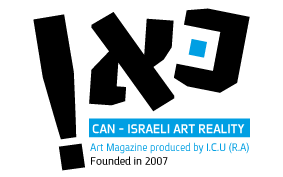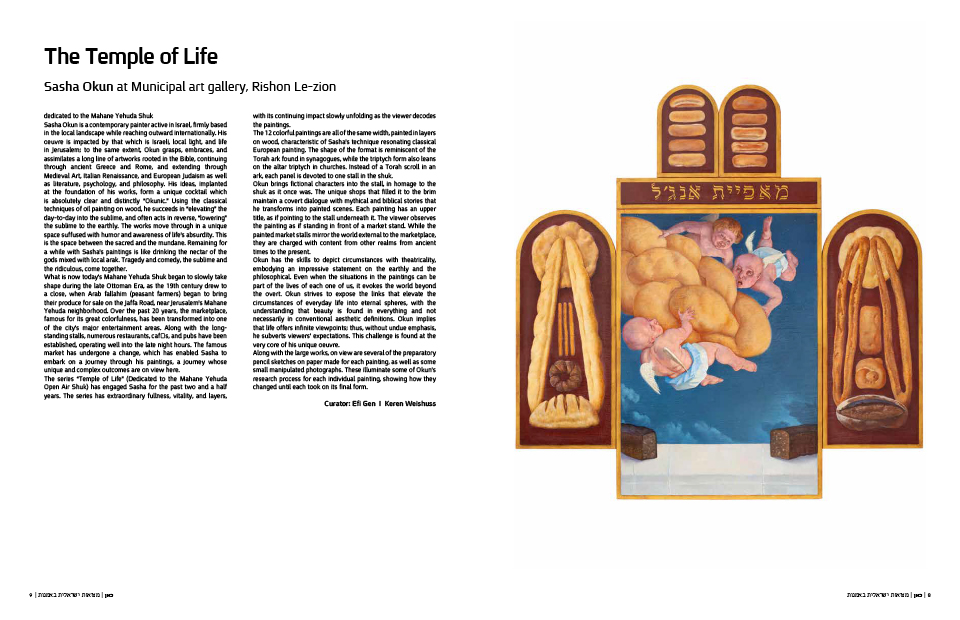
| Home Page | Editor Notices | Museums | Galleries | Publication | Donation | Contact Us |


 | |||||||||||||||
| |||||||||||||||


| |||||||||||||||
| Sasha Okun at Municipal art gallery, Rishon Le-zion |
dedicated to the Mahane Yehuda Shuk Sasha Okun is a contemporary painter active in Israel, firmly based in the local landscape while reaching outward internationally. His oeuvre is impacted by that which is Israeli, local light, and life in Jerusalem; to the same extent, Okun grasps, embraces, and assimilates a long line of artworks rooted in the Bible, continuing through ancient Greece and Rome, and extending through Medieval Art, Italian Renaissance, and European Judaism as well as literature, psychology, and philosophy. His ideas, implanted at the foundation of his works, form a unique cocktail which is absolutely clear and distinctly “Okunic.” Using the classical techniques of oil painting on wood, he succeeds in “elevating” the day-to-day into the sublime, and often acts in reverse, “lowering” the sublime to the earthly. The works move through in a unique space suffused with humor and awareness of life’s absurdity. This is the space between the sacred and the mundane. Remaining for a while with Sasha’s paintings is like drinking the nectar of the gods mixed with local arak. Tragedy and comedy, the sublime and the ridiculous, come together. What is now today’s Mahane Yehuda Shuk began to slowly take shape during the late Ottoman Era, as the 19th century drew to a close, when Arab fallahim (peasant farmers) began to bring their produce for sale on the Jaffa Road, near Jerusalem’s Mahane Yehuda neighborhood. Over the past 20 years, the marketplace, famous for its great colorfulness, has been transformed into one of the city’s major entertainment areas. Along with the long-standing stalls, numerous restaurants, caf?s, and pubs have been established, operating well into the late night hours. The famous market has undergone a change, which has enabled Sasha to embark on a journey through his paintings, a journey whose unique and complex outcomes are on view here. The series “Temple of Life” (Dedicated to the Mahane Yehuda Open Air Shuk) has engaged Sasha for the past two and a half years. The series has extraordinary fullness, vitality, and layers, with its continuing impact slowly unfolding as the viewer decodes the paintings. The 12 colorful paintings are all of the same width, painted in layers on wood, characteristic of Sasha’s technique resonating classical European painting. The shape of the format is reminiscent of the Torah ark found in synagogues, while the triptych form also leans on the altar triptych in churches. Instead of a Torah scroll in an ark, each panel is devoted to one stall in the shuk. Okun brings fictional characters into the stall, in homage to the shuk as it once was. The unique shops that filled it to the brim maintain a covert dialogue with mythical and biblical stories that he transforms into painted scenes. Each painting has an upper title, as if pointing to the stall underneath it. The viewer observes the painting as if standing in front of a market stand. While the painted market stalls mirror the world external to the marketplace, they are charged with content from other realms from ancient times to the present. Okun has the skills to depict circumstances with theatricality, embodying an impressive statement on the earthly and the philosophical. Even when the situations in the paintings can be part of the lives of each one of us, it evokes the world beyond the overt. Okun strives to expose the links that elevate the circumstances of everyday life into eternal spheres, with the understanding that beauty is found in everything and not necessarily in conventional aesthetic definitions. Okun implies that life offers infinite viewpoints; thus, without undue emphasis, he subverts viewers’ expectations. This challenge is found at the very core of his unique oeuvre. Along with the large works, on view are several of the preparatory pencil sketches on paper made for each painting, as well as some small manipulated photographs. These illuminate some of Okun’s research process for each individual painting, showing how they changed until each took on its final form. Curator: Efi Gen I Keren Weishuss Read more  |
| all rights reserved - CAN ISRAELI ART REALITY |
| סייבורג מחשבים - בניית אתרים |